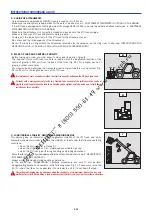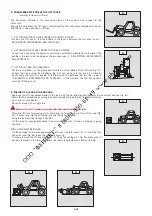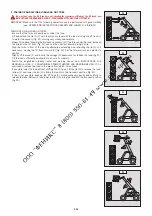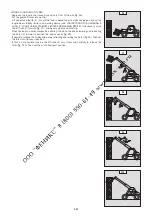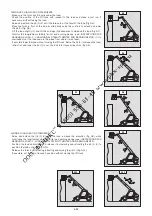
1-4
INSTRUCTIONS TO THE COMPANY MANAGER
THE SITE
- Proper management of lift truck’s area of travel will reduce the risk of accidents:
. ground not unnecessarily uneven or obstructed,
. no excessive slopes,
. pedestrian traffic controlled, etc.
THE OPERATOR
- Only qualified, authorized personnel can use the lift truck. This authorization is given in writing by the appropriate person in the
establishment with respect to the use of lift trucks and must be carried permanently by the operator.
On the basis of experience, there are a number of possible situations in which operating the lift truck is contra-indicated. Such foreseeable abnormal
uses, the main ones being listed below, are strictly forbidden.
- The foreseeable abnormal behaviour resulting from ordinary neglect, but does not result from any wish to put the machinery to any improper use.
- The reflex reactions of a person in the event of a malfunction, incident, fault, etc. during operation of the lift truck.
- Behaviour resulting from application of the «principle of least action» when performing a task.
- For certain machines, the foreseeable behaviour of such persons as: apprentices, teenagers, handicapped persons, trainees tempted to drive a
lift truck, operator tempted to operate a truck to win a bet, in competition or for their own personal experience.
The person in charge of the equipment must take these criteria into account when assessing whether or not a person will makea suitable driver.
THE LIFT TRUCK
A - THE TRUCK’S SUITABILITY FOR THE JOB
- MANITOU has ensured that this lift truck is suitable for use under the standard operating conditions defined in this operator’s
manual, with a
STATIC
test coefficient
OF 1.33
and a
DYNAMIC
test coefficient
OF 1
, as specified in harmonized norm
EN 1459
for variable range trucks.
- Before commissioning, the company manager must make sure that the lift truck is appropriate for the work to be done, and
per form cer tain tests (in accordance with current legislation).
B - ADAPTATION OF THE LIFT TRUCK TO STANDARD ENVIRONMENTAL CONDITIONS
- In addition to series equipment mounted on your lift truck, many options are available, such as: road lighting, stop lights, flashing
light, reverse lights, reverse buzzer alarm, front light, rear light, light at the jib head, etc.
- The operator must take into account the operating conditions to define the lift truck’s signalling and lighting equipment.
Contact your dealer.
- Take into account climatic and atmospheric conditions of the site of utilisation.
. Protection against frost (see: 3 - MAINTENANCE: LUBRICANTS AND FUEL).
. Adaptation of lubricants (ask your dealer for information).
. I.C. engine filtration (see: 3 - MAINTENANCE: FILTERS CARTRIDGES AND BELTS).
For operation under average climatic conditions, i.e.: between - 15 °C and + 35 °C, correct levels of lubricants in all the circuits are checked in production.
For operation under more severe climatic conditions, before starting up, it is necessary to drain all the circuits, then ensure correct levels of lubricants
using lubricants properly suited to the relevant ambient temperatures. It is the same for the cooling liquid.
- A lift truck operating in an area without fire extinguishing equipment must be equipped with an individual extinguisher. There are
solutions, consult your dealer.
Your lift truck is designed for outdoor use under normal atmospheric conditions and indoor use in suitably aerated and ventilated premises. It is prohibited
to use the lift truck in areas where there is a risk of fire or which are potentially explosive (e.g. Refineries, fuel or gas depots, stores of inflammable
products…). For use in these areas, specific equipment is available (ask your dealer for information).
- Our trucks comply with Directive 2004/108/EC concerning electromagnetic compatibility (EMC), and with the corresponding
harmonized norm EN 12895. Their proper operation is no longer guaranteed if they are used within areas in which the
electromagnetic fields exceed the limit specified by that norm (10 V/m).
- Directive 2002/44/EC requires company managers to not expose their employees to excessive vibration doses. There is no
recognized code of measurement for comparing the machines of different manufacturers. The actual doses received can therefore
be measured only under actual operating conditions at the user's premises.
- The following are some tips for minimizing these vibration doses:
• Select the most suitable lift truck and attachment for the intended use.
• Adapt the seat adjustment to the operator's weight (according to lift truck model) and maintain it in good condition, as
well as the cab suspension. Inflate the tires in accordance with recommendations.
• Ensure that the operators adapt their operating speed to suit the conditions on site.
• As far as possible, arrange the site in such a way as to provide a flat running sur face and remove obstacles and harmful
potholes.
Summary of Contents for MT 1058 R PRIVILEGE
Page 1: ......
Page 3: ......
Page 4: ...1 1 1 OPERATING AND SAFETY INSTRUCTIONS...
Page 5: ...1 2...
Page 31: ...1 28...
Page 32: ...2 1 2 DESCRIPTION...
Page 33: ...2 2...
Page 44: ...2 13...
Page 74: ...2 43...
Page 78: ...3 1 3 MAINTENANCE...
Page 79: ...3 2...
Page 84: ...3 7...
Page 92: ...3 15...
Page 104: ...3 27...
Page 116: ...4 1 4 OPTIONAL ATTACHMENTS FOR USE WITH THE RANGE...
Page 117: ...4 2...
Page 119: ...4 4...
Page 129: ...4 14...
Page 130: ...5 1 5 SPECIFIC CANADA...
Page 131: ...5 2...
Page 132: ...5 3 TABLE OF CONTENTS DIMENSIONS AND LOAD CHART MT 1058 R PRIVILEGE 5 4...
Page 135: ...5 6...
Page 136: ...6 1 6 SPECIFIC AUSTRALIA See also the operator s manual supplement 647065 AU...
Page 137: ...6 2...
Page 139: ...6 4...

















